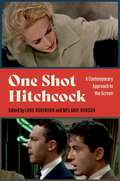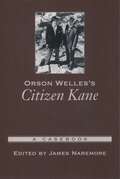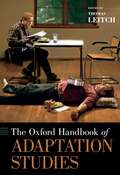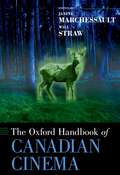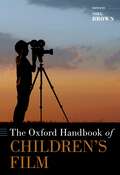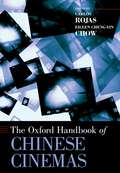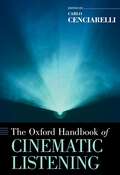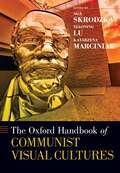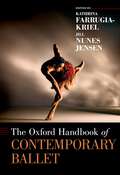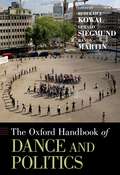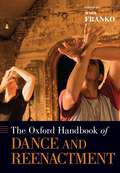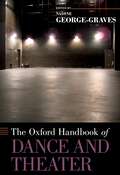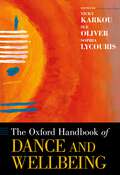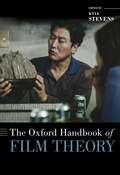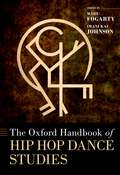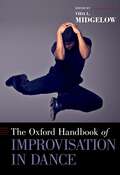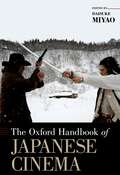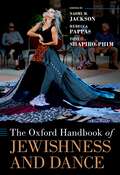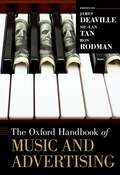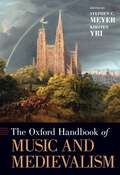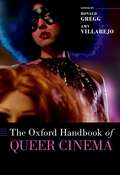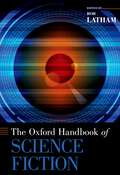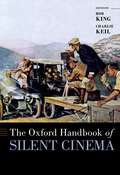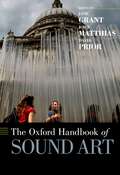- Table View
- List View
One Shot Hitchcock: A Contemporary Approach to the Screen
In recent years, the enduring appeal of Alfred Hitchcock to film studies has been evidenced by the proliferation of innovative approaches to the director's work. Adding to this pattern of innovation, the edited collection One Shot Hitchcock: A Contemporary Approach to the Screen utilizes formal analysis to interrogate key single shots from across Alfred Hitchcock's long career. This collection reveals the value of analyzing the single shot - within this small, cinematic unit is a code that unlocks a series of revelations about cinema as an artistic practice and a theoretical study. Each chapter examines one shot from a single film, beginning with The Lodger (1927) and ending with Frenzy (1972). If Hitchcock is known as a director of suspense films and films about murder, the shots discussed in One Shot Hitchcock are his crime scenes. These are the shots that resist being forgotten, that repeatedly demand to be investigated, in which Hitchcock's influence on aesthetics and culture is at its most acute. Each chapter uses a different lens of film analysis - transnationalism, gender and sexuality, performance, history, affect, intermediality, remake studies, philosophy, and film form are all used to interrogate single shots. In these essays, the single shot from Hitchcock's film not only illustrates the approach in question but also demonstrates how the single shot encourages us to rethink our approaches to the screen. By reinvigorating a close formal mode of analysis, One Shot Hitchcock asks readers to think differently about film, offering a renewed assessment of Hitchcock's oeuvre in the process.
Orson Welles's Citizen Kane: A Casebook (Casebooks in Criticism)
Citizen Kane is arguably the most admired and significant film since the advent of talking pictures. No other film is quite so interesting from both artistic and political points of view. To study it even briefly is to learn a great deal about American history, motion-picture style, and the literary aspects of motion-picture scripts. Rather than presenting a sterile display of critical methodologies, James Naremore has gathered a set of essays that represent the essential writings on the film. It gives the reader a lively set of critical interpretations, together with the necessary production information, historical background, and technical understanding to comprehend the film's larger cultural significance. Selections range from the anecdotal --Peter Bogdanovich's interview with Orson Welles--to the critical, with discussions on the scripts and sound track, and a discussion of what accounts for the film's enduring popularity. Contributors include James Naremore, Peter Bogdanovich, Jonathan Rosenbaum, Robert L. Carringer, François Thomas, Michael Denning, Laura Mulvey, Peter Wollen, and Paul Arthur.
The Oxford Handbook of Adaptation Studies (Oxford Handbooks)
This collection of forty new essays, written by the leading scholars in adaptation studies and distinguished contributors from outside the field, is the most comprehensive volume on adaptation ever published. Written to appeal alike to specialists in adaptation, scholars in allied fields, and general readers, it hearkens back to the foundations of adaptation studies a century and more ago, surveys its ferment of activity over the past twenty years, and looks forward to the future. It considers the very different problems in adapting the classics, from the Bible to Frankenstein to Philip Roth, and the commons, from online mashups and remixes to adult movies. It surveys a dizzying range of adaptations around the world, from Latin American telenovelas to Czech cinema, from Hong Kong comics to Classics Illustrated, from Bollywood to zombies, and explores the ways media as different as radio, opera, popular song, and videogames have handled adaptation. Going still further, it examines the relations between adaptation and such intertextual practices as translation, illustration, prequels, sequels, remakes, intermediality, and transmediality. The volume's contributors consider the similarities and differences between adaptation and history, adaptation and performance, adaptation and revision, and textual and biological adaptation, casting an appreciative but critical eye on the theory and practice of adaptation scholars--and, occasionally, each other. The Oxford Handbook of Adaptation Studies offers specific suggestions for how to read, teach, create, and write about adaptations in order to prepare for a world in which adaptation, already ubiquitous, is likely to become ever more important.
The Oxford Handbook of Canadian Cinema (Oxford Handbooks)
The chapters in The Oxford Handbook of Canadian Cinema present a rich, diverse overview of Canadian cinema. Responding to the latest developments in Canadian film studies, this volume takes into account the variety of artistic voices, media technologies, and places which have marked cinema in Canada throughout its history. Drawing on a range of established and emerging scholars from a range of disciplines, this volume will be useful to teachers, scholars, and to a general readership interested in cinema in Canada. Moving beyond the director-focused approach of much previous scholarship, this book is concerned with communities, institutions, and audiences for Canadian cinema at both national and international levels. The choice of subjects covered ranges from popular, genre cinema to the most experimental of artistic interventions. Canadian cinema is seen in its interaction with other forms of art-making and media production in Canada and at the international level. Particular attention has been paid to the work of Indigenous filmmakers, members of diasporic communities and feminist and LGBTQ artists. The result is a book attentive to the complex social and institutional contexts in which Canadian cinema is made and consumed.
The Oxford Handbook of Children's Film (Oxford Handbooks)
The Oxford Handbook of Children's Film is the most comprehensive study of international children's cinema published to date. Overturning common prejudices that films for children are unworthy of serious attention, it presents nuanced and wide-ranging discussions from senior and junior scholars alike of iconic and neglected productions from Hollywood, Britain, France, Germany, Sweden, Norway, Hungary, Australia, China, Japan, South Korea, India, Iran, Kenya, and several other countries. Featuring contributions by leading scholars in the field, the volume considers a range of issues central to the study of children's film, including questions of form and definition; representations of childhood and growing up; music, stardom, and performance; how children's films reflect national identity or serve as vehicles of state ideology and propaganda; the phenomenon of Hollywood 'family entertainment', especially the role of the Disney company; and how children and young people (as well as older audiences) engage with children's film culture. As a whole, the volume makes a substantial contribution to the emerging field of children's film studies, and will be of great interest to scholars of children's media and culture more broadly.
The Oxford Handbook of Chinese Cinemas (Oxford Handbooks)
What does it mean for a cinematic work to be "Chinese"? Does it refer specifically to a work's subject, or does it also reflect considerations of language, ethnicity, nationality, ideology, or political orientation? Such questions make any single approach to a vast field like "Chinese cinema" difficult at best. Accordingly, The Oxford Handbook of Chinese Cinemas situates the term more broadly among various different phases, genres, and distinct national configurations, while taking care to address the consequences of grouping together so many disparate histories under a single banner. Offering both a platform for cross-disciplinary dialogue and a mapping of Chinese cinema as an expanded field, this Handbook presents thirty-three essays by leading researchers and scholars intent on yielding new insights and new analyses using three different methodologies. Chapters in Part I investigate the historical periodizations of the field through changing notions of national and political identity -- all the way from the industry's beginnings in the 1920s up to its current forms in contemporary Hong Kong, Taiwan, and the global diaspora. Chapters in Part II feature studies centered on the field's taxonomical formalities, including such topics as the role of the Chinese opera in technological innovation, the political logic of the "Maoist film," and the psychoanalytic formula of the kung fu action film. Finally, in Part III, focus is given to the structural elements that comprise a work's production, distribution, and reception to reveal the broader cinematic apparatuses within which these works are positioned. Taken together, the multipronged approach supports a wider platform beyond the geopolitical and linguistic limitations in existing scholarship. Expertly edited to illustrate a representative set of up to date topics and approaches, The Oxford Handbook of Chinese Cinemas provides a vital addition to a burgeoning field still in its formative stages.
The Oxford Handbook of Cinematic Listening (Oxford Handbooks)
The Oxford Handbook of Cinematic Listening explores the place of cinema in the history of listening. It looks at the ways in which listening to film is situated in textual, spatial, and social practices, and also studies how cinematic modes of listening have extended into other media and everyday experiences. Chapters are structured around six themes. Part I ("Genealogies and Beginnings") considers film sound in light of pre-existing practices such as opera and shadow theatre, and also explores changes in listening taking place at critical junctures in the early history of cinema. Part II ("Locations and Relocations") focuses on specific venues and presentational practices from roadshow movies to contemporary live-score screenings. Part III ("Representations and Re-Presentations") zooms into the formal properties of specific films, analyzing representations of listening on screen as well as the role of sound as a representational surplus. Part IV ("The Listening Body") focuses on the power of cinematic sound to engage the full body sensorium. Part V ("Listening Again") discusses a range of ways in which film sound is encountered and reinterpreted outside the cinema, whether through ancillary materials such as songs and soundtrack albums, or in experimental conditions and pedagogical contexts. Part VI ("Across Media") compares cinema with the listening protocols of TV series and music video, promenade theatre and personal stereos, video games and Virtual Reality.
The Oxford Handbook of Communist Visual Cultures (Oxford Handbooks)
Stereotypes often cast communism as a defunct, bankrupt ideology and a relic of the distant past. However, recent political movements like Europe's anti-austerity protests, the Arab Spring, and Occupy Wall Street suggest that communism is still very much relevant and may even hold the key to a new, idealized future. In The Oxford Handbook of Communist Visual Cultures, contributors trace the legacies of communist ideology in visual culture, from buildings and monuments, murals and sculpture, to recycling campaigns and wall newspapers, all of which work to make communism's ideas and values material. Contributors work to resist the widespread demonization of communism, demystifying its ideals and suggesting that it has visually shaped the modern world in undeniable and complex ways. Together, contributors answer curcial questions like: What can be salvaged and reused from past communist experiments? How has communism impacted the cultures of late capitalism? And how have histories of communism left behind visual traces of potential utopias? An interdisciplinary look at the cultural currency of communism today, The Oxford Handbook of Communist Visual Cultures demonstrates the value of revisiting the practices of the past to form a better vision of the future.
The Oxford Handbook of Contemporary Ballet (Oxford Handbooks)
In distinction to many extant histories of ballet, The Oxford Handbook of Contemporary Ballet prioritizes connections between ballet communities as it interweaves chapters by scholars, critics, choreographers, and working professional dancers. The book looks at the many ways ballet functions as a global practice in the 21st century, providing new perspectives on ballet's past, present, and future. As an effort to dismantle the linearity of academic canons, the fifty-three chapters within provide multiple entry points for readers to engage in balletic discourse. With an emphasis on composition and process alongside dances created, and the assertion that contemporary ballet is a definitive era, the book carves out space for critical inquiry. Many of the chapters consider whether or not ballet can reconcile its past and actually become present, while others see ballet as flexible and willing to be remolded at the hands of those with tools to do so.
The Oxford Handbook of Dance and Politics (Oxford Handbooks)
In recent decades, dance has become a vehicle for querying assumptions about what it means to be embodied, in turn illuminating intersections among the political, the social, the aesthetical, and the phenomenological. The Oxford Handbook of Dance and Politics edited by internationally lauded scholars Rebekah Kowal, Gerald Siegmund, and the late Randy Martin presents a compendium of newly-commissioned chapters that address the interdisciplinary and global scope of dance theory - its political philosophy, social movements, and approaches to bodily difference such as disability, postcolonial, and critical race and queer studies. In six sections 30 of the most prestigious dance scholars in the US and Europe track the political economy of dance and analyze the political dimensions of choreography, of writing history, and of embodied phenomena in general. Employing years of intimate knowledge of dance and its cultural phenomenology, scholars urge readers to re-think dominant cultural codes, their usages, and the meaning they produce and theorize ways dance may help to re-signify and to re-negotiate established cultural practices and their inherent power relations. This handbook poses ever-present questions about dance politics-which aspects or effects of a dance can be considered political? What possibilities and understandings of politics are disclosed through dance? How does a particular dance articulate or undermine forces of authority? How might dance relate to emancipation or bondage of the body? Where and how can dance articulate social movements, represent or challenge political institutions, or offer insight into habits of labor and leisure? The handbook opens its critical terms in two directions. First, it offers an elaborated understanding of how dance achieves its politics. Second, it illustrates how notions of the political are themselves expanded when viewed from the perspective of dance, thus addressing both the relationship between the politics in dance and the politics of dance. Using the most sophisticated theoretical frameworks and engaging with the problematics that come from philosophy, social science, history, and the humanities, chapters explore the affinities, affiliations, concepts, and critiques that are inherent in the act of dance, and questions about matters political that dance makes legible.
The Oxford Handbook of Dance and Reenactment (Oxford Handbooks)
The Oxford Handbook of Dance and Reenactment brings together a cross-section of artists and scholars engaged with the phenomenon of reenactment in dance from a practical and theoretical standpoint. Synthesizing myriad views on danced reenactment and the manner in which this branch of choreographic performance intersects with important cultural concerns around appropriation this Handbook addresses originality, plagiarism, historicity, and spatiality as it relates to cultural geography. Others topics treated include transmission as a heuristic device, the notion of the archive as it relates to dance and as it is frequently contrasted with embodied cultural memory, pedagogy, theory of history, reconstruction as a methodology, testimony and witnessing, theories of history as narrative and the impact of dance on modernist literature, and relations of reenactment to historical knowledge and new media.
The Oxford Handbook of Dance and Theater (Oxford Handbooks)
The Oxford Handbook of Dance and Theater collects a critical mass of border-crossing scholarship on the intersections of dance and theatre. Taking corporeality as an idea that unites the work of dance and theater scholars and artists, and embodiment as a negotiation of power dynamics with important stakes, these essays focus on the politics and poetics of the moving body in performance both on and off stage. Contemporary stage performances have sparked global interest in new experiments between dance and theater, and this volume situates this interest in its historical context by extensively investigating other such moments: from pagan mimes of late antiquity to early modern archives to Bolshevik Russia to post-Sandinista Nicaragua to Chinese opera on the international stage, to contemporary flash mobs and television dance contests. Ideologically, the essays investigate critical race theory, affect theory, cognitive science, historiography, dance dramaturgy, spatiality, gender, somatics, ritual, and biopolitics among other modes of inquiry. In terms of aesthetics, they examine many genres such as musical theater, contemporary dance, improvisation, experimental theater, television, African total theater, modern dance, new Indian dance theater aesthetics, philanthroproductions, Butoh, carnival, equestrian performance, tanztheater, Korean Talchum, Nazi Movement Choirs, Lindy Hop, Bomba, Caroline Masques, political demonstrations, and Hip Hop. The volume includes innovative essays from both young and seasoned scholars and scholar/practitioners who are working at the cutting edges of their fields. The handbook brings together essays that offer new insight into well-studied areas, challenge current knowledge, attend to neglected practices or moments in time, and that identify emergent themes. The overall result is a better understanding of the roles of dance and theater in the performative production of meaning.
The Oxford Handbook of Dance and Wellbeing (Oxford Handbooks)
In recent years, a growth in dance and wellbeing scholarship has resulted in new ways of thinking that place the body, movement, and dance in a central place with renewed significance for wellbeing. The Oxford Handbook of Dance and Wellbeing examines dance and related movement practices from the perspectives of neuroscience and health, community and education, and psychology and sociology to contribute towards an understanding of wellbeing, offer new insights into existing practices, and create a space where sufficient exchange is enabled. The handbook's research components include quantitative, qualitative, and arts-based research, covering diverse discourses, methodologies, and perspectives that add to the development of a complete picture of the topic. Throughout the handbook's wide-ranging chapters, the objective observations, felt experiences, and artistic explorations of practitioners interact with and are printed alongside academic chapters to establish an egalitarian and impactful exchange of ideas.
The Oxford Handbook of Film Theory (OXFORD HANDBOOKS SERIES)
Despite changes in the media landscape, film remains a vital force in contemporary culture, as do our ideas of what "a movie" or "the cinematic" are. Indeed, we might say that the category of film now only exists in theory. Whereas film-theoretical discussion at the turn of the 21st century was preoccupied, understandably, by digital technology's permeation of virtually all aspects of the film object, this volume moves the conversation away from a focus on film's materiality towards timely questions concerning the ethics, politics, and even aesthetics of thinking about the medium of cinema. To put it another way, this collection narrows in on the subject of film, not with a nostalgic sensibility, but with the recognition that what constitutes a film is historically contingent, in dialogue with the vicissitudes of entertainment, art, and empire. The volume is divided into six sections: Meta-Theory; Film Theory's Project of Emancipation; Apparatus and Perception; Audiovisuality; How Close is Close Reading?; and The Turn to Experience.
The Oxford Handbook of Hip Hop Dance Studies (Oxford Handbooks)
Engaging with a broad range of research and performance genres, The Oxford Handbook of Hip Hop Dance Studies offers the most comprehensive research on Hip Hop dance to date. Filling a lacuna in both Hip Hop and dance studies, the Handbook places practitioners' voices at the forefront and in dialogue with theoretical insights, rooted in critical race theory, anticolonialism, intersectional feminism, and more. Volume editors Mary Fogarty and Imani Kai Johnson have included influential dancers and scholars from around the world: from B-Boys Ken Swift, YNOT, and Storm, to practitioners of locking, waacking and House dance styles such as E. Moncell Durden, Terry Bright Kweku Ofosu, Fly Lady Di, and Leah McFly, and innovative academic work on Hip Hop dance by the most prominent researchers in the field. Throughout the Handbook contributors address individual and social histories of dance, Afrodiasporic and global lineages, the contribution of B-Girls from Honey Rockwell to Rokafella, the "studio-fication" of Hip Hop styles, and moves into theatre, TV, and the digital/social media space.
The Oxford Handbook of Improvisation in Dance (Oxford Handbooks)
From the dance floor of a tango club to group therapy classes, from ballet to community theatre, improvised dance is everywhere. For some dance artists, improvisation is one of many approaches within the choreographic process. For others, it is a performance form in its own right. And while it has long been practiced, it is only within the last twenty years that dance improvisation has become a topic of critical inquiry. With The Oxford Handbook of Improvisation in Dance, dancer, teacher, and editor Vida L. Midgelow provides a cutting-edge volume on dance improvisation in all its facets. Expanding beyond conventional dance frameworks, this handbook looks at the ways that dance improvisation practices reflect our ability to adapt, communicate, and respond to our environment. Throughout the handbook, case studies from a variety of disciplines showcase the role of individual agency and collective relationships in improvisation, not just to dancers but to people of all backgrounds and abilities. In doing so, chapters celebrate all forms of improvisation, and unravel the ways that this kind of movement informs understandings of history, socio-cultural conditions, lived experience, cognition, and technologies.
The Oxford Handbook of Japanese Cinema
The reality of transnational innovation and dissemination of new technologies, including digital media, has yet to make a dent in the deep-seated culturalism that insists on reinscribing a divide between the West and Japan. The Oxford Handbook of Japanese Cinema aims to counter this trend toward dichotomizing the West and Japan and to challenge the pervasive culturalism of today's film and media studies. Featuring twenty essays, each authored by a leading researcher in the field, this volume addresses productive debates about where Japanese cinema is and where Japanese cinema is going at the period of crisis of national boundary under globalization. It reevaluates the position of Japanese cinema within the discipline of cinema and media studies and beyond, and situates Japanese cinema within the broader fields of transnational film history. Likewise, it examines the materiality of Japanese cinema, scrutinizes cinema's relationship to other media, and identifies the specific practices of film production and reception. As a whole, the volume fosters a dialogue between Japanese scholars of Japanese cinema, film scholars of Japanese cinema based in Anglo-American and European countries, film scholars of non-Japanese cinema, film archivists, film critics, and filmmakers familiar with film scholarship. A comprehensive volume that grasps Japanese cinema under the rubric of the global and also fills the gap between Japanese and non-Japanese film studies and between theories and practices, The Oxford Handbook of Japanese Cinema challenges and responds to the major developments underfoot in this rapidly changing field.
The Oxford Handbook of Jewishness and Dance (Oxford Handbooks)
Responding to recent evolutions in the fields of dance and religious and secular studies, The Oxford Handbook of Jewishness and Dance documents and celebrates the significant impact of Jewish identity on a variety of communities and the dance world writ large. Focusing on North America, Europe, and Israel in the twentieth and twenty-first centuries, this Handbook highlights the sometimes surprising, often hidden and overlooked Jewish resonances within a range of styles from modern and postmodern dance to folk dance and flamenco. Privileging the historically marginalized voices of scholars, performers, and instructors the Handbook considers the powerful role of dance in addressing difference, such as between American and Israeli Jewish communities. In the process, contributors advocate values of social justice, like Tikkun Olam (repair of the world), debate, and humor, exploring the fascinating and potentially uncomfortable contradictions and ambiguities that characterize this robust area of research.
The Oxford Handbook of Music and Advertising (Oxford Handbooks)
The Oxford Handbook of Music and Advertising is an essential guide to the crucial role that music plays in relation to the audio or audiovisual advertising message, from the perspectives of its creation, interpretation, and reception. The book's unique three-part organization reflects this life cycle of an advertisement, from industry inception to mass-mediated text to consumer behaviour. Experts well versed in the practice, analysis, and empirical studies of the commercial message have contributed to the collection's forty-two chapters, which collectively represent the most ambitious and comprehensive attempt to date to address the important intersections of music and advertising. Handbook chapters are self-contained yet share borders with other contributions within a given section and across the major sections of the book, so readers can either study one topic of particular interest or read through to gain an understanding of the broader issues at stake. Within the book's Introduction, each editor has provided an overview of the unifying themes for the section for which they were responsible, with brief summaries of individual contributions at the beginnings of the sections. The lists of recommended readings at the end of chapters are intended to assist readers in finding further literature about the topic. An overview of industry practices by a music insider is provided in the Appendix, giving context for the three parts of the book.
The Oxford Handbook of Music and Medievalism (Oxford Handbooks)
The Oxford Handbook of Music and Medievalism provides a snapshot of the diverse ways in which medievalism--the retrospective immersion in the images, sounds, narratives, and ideologies of the European Middle Ages--powerfully transforms many of the varied musical traditions of the last two centuries. Thirty-three chapters from an international group of scholars explore topics ranging from the representation of the Middle Ages in nineteenth-century opera to medievalism in contemporary video game music, thereby connecting disparate musical forms across typical musicological boundaries of chronology and geography. While some chapters focus on key medievalist works such as Orff's Carmina Burana or Peter Jackson's Lord of the Rings films, others explore medievalism in the oeuvre of a single composer (e.g. Richard Wagner or Arvo Pärt) or musical group (e.g. Led Zeppelin). The topics of the individual chapters include both well-known works such as John Boorman's film Excalibur and also less familiar examples such as Eduard Lalo's Le Roi d'Ys. The authors of the chapters approach their material from a wide array of disciplinary perspectives, including historical musicology, popular music studies, music theory, and film studies, examining the intersections of medievalism with nationalism, romanticism, ideology, nature, feminism, or spiritualism. Taken together, the contents of the Handbook develop new critical insights that venture outside traditional methodological constraints and provide a capstone and point of departure for future scholarship on music and medievalism.
The Oxford Handbook of Queer Cinema (Oxford Handbooks)
The term "queer cinema" is often used to name at least three cultural events: 1) an emergent visual culture that boldly identifies as queer; 2) a body of narrative, documentary, and experimental work previously collated under the rubric of homosexual or lesbian, gay, bisexual, and trans (LGBT) cinema; 3) a means of critically reading and evaluating films and other visual media through the lens of sexuality. By this expansive account, queer cinema encompasses more than a century of filmmaking, film criticism, and film reception, and the past twenty-five years have seen the idea of "queer cinema" expand further as a descriptor for a global arts practice. As the first of its kind, The Oxford Handbook of Queer Cinema treats these three currents as art and critical practice, bringing the canon of queer cinema together with a new generation of makers and scholars. The Handbook's contributors include scholars who research the worldwide canon of queer cinema, those who are uniquely positioned to address three decades of its particular importance, and those best positioned to ponder the forms it is taking or may take in our new century, namely digital media that moves in new circuits. In eight sections, they explore the many forms that queer cinema takes across time, discussing narrative, experimental, documentary, and genre filmmaking, including pornography. Likewise, although the study of cinema and media is not restricted to a single method, chapters showcase the unique combination of textual analysis, industrial and production history, interpretation, ethnography, and archival research that this field enables. For example, chapters analyze the ways in which queer cinema both is and is not self-evidently an object for study by examining films that reinforce negative understandings of queerness alongside those that liberate the subject; and by naming the films that are newly queered, while noting that many queerly-made texts await discovery. Finally, chapters necessarily assert that queer cinema is not an Anglophone phenomenon, nor is it restricted to the medium of film.
The Oxford Handbook of Radio and Podcasting (Oxford Handbooks)
Radio today remains the most accessible and widely available communication medium worldwide, despite technological shifts and a host of upstart challengers. Since its origins in the 1920s, radio has innovated a new world of sound culture - now expanded into the digital realm of podcasting that is enabling the medium to reach larger audiences than ever before. Yet radio remains one of the least studied of the major areas of communication arts, due largely to its broadcast-era ephemerality. With the advent of digital technology, radio's past has been unlocked and soundwork is exploding as a creative field, creating a lively and diverse sonic present while simultaneously making critical historical analysis possible at last. This volume offers newly commissioned chapters giving readers a wide-ranging view of current critical work in the fields of radio and podcasting, employing specific case studies to analyze sound media's engagement with the arts; with the factual world of news, talk, and documentary programming; as a primary means of forging community along with national, transnational, and alternative identities; and as a subject of academic and critical research. Its historical scope extends from radio's earliest days, through its mid-twentieth century decades as the powerful voice of nations and empires, onto its transformation into a secondary medium during the television era, and into the expanding digital present. Over the course of 37 chapters, it provides evidence of the sound media's flexibility and adaptation across diverse cultures by examining radio's past and present uses in regions including the United States, Canada, Britain, Australia, Poland, China, Korea, Kenya, Angola and Mozambique, South Asia, and the Caribbean. Contributors include historians and media scholars as well as sound artists and radio/podcast producers. Notably, companion links to digital ?quotations? from works analyzed are included in many chapters along with chapter audiographies offering links to further listening. Throughout, The Oxford Handbook of Radio and Podcasting connects radio's broadcast past to its digital present, and traces themes of creativity, identity, community, nation, and transnationality across more than a century of audio media.
The Oxford Handbook of Science Fiction (Oxford Handbooks)
The excitement of possible futures found in science fiction has long fired the human imagination, but the genre's acceptance by academe is relatively recent. No longer marginalized and fighting for respectability, science-fictional works are now studied alongside more traditional art forms. Tracing the capacious genre's birth, evolution, and impact across nations, time periods, subgenres, and media, The Oxford Handbook of Science Fiction offers an in-depth, comprehensive assessment of this robust area of scholarly inquiry and considers the future directions that will dictate the terms of the scholarly discourse. The Handbook begins with a focus on questions of genre, covering topics such as critical history, keywords, narrative, the fantastic, and fandom. A subsequent section on media engages with film, television, comics, architecture, music, video games, and more. The genre's role in the convergence of art and everyday life animates a third section, which addresses topics such as UFOs,
The Oxford Handbook of Silent Cinema (Oxford Handbooks)
With thirty-four original chapters from three dozen top scholars, The Oxford Handbook of Silent Cinema provides a thoughtful and provocative re-examination of a medium that would become the dominant form of mass entertainment by the second decade of the twentieth century. The volume is arranged around a series of broad topics: the "invention" of cinema as both technology and medium; the intermedial development of film aesthetics and genres; nontheatrical and non-commercial uses of cinema; the political economy of Hollywood mass culture; film and global modernities; and silent cinema's publics and counter-publics. The historiographical essays in this collection engage with the question of how we might rethink silent film history, especially in the context of the developed media ecosystem that defined the early 1900s. Influenced by methodologies as diverse as media archaeology and industrial studies, and sensitive to both the textual contours of silent films and the cultural, economic, and ideological currents that helped shape them, the Oxford Handbook of Silent Cinema invites its reader to envision its object in expansive terms that incorporate the propulsive energy of the first decades of the 1900s and deploy the analytical frameworks of the current day.
The Oxford Handbook of Sound Art (Oxford Handbooks)
Sound art has long been resistant to its own definition. Emerging from a liminal space between movements of thought and practice in the twentieth century, sound art has often been described in terms of the things that it is understood to have left behind: a space between music, fine art, and performance. The Oxford Handbook of Sound Art surveys the practices, politics, and emerging frameworks of thought that now define this previously amorphous area of study. Throughout the Handbook, artists and thinkers explore the uses of sound in contemporary arts practice. Imbued with global perspectives, chapters are organized in six overarching themes of Space, Time, Things, Fabric, Senses and Relationality. Each theme represents a key area of development in the visual arts and music during the second half of the twentieth century from which sound art emerged. By offering a set of thematic frameworks through which to understand these themes, this Handbook situates constellations of disparate thought and practice into recognized centers of activity.
